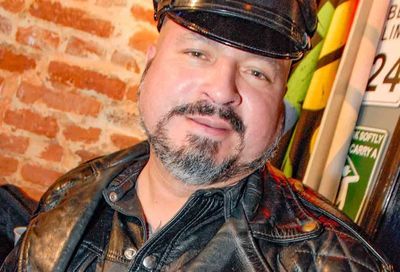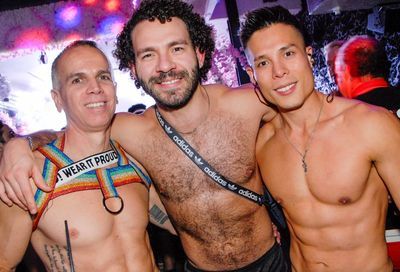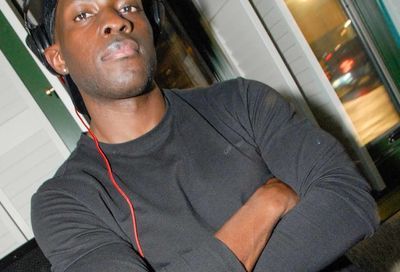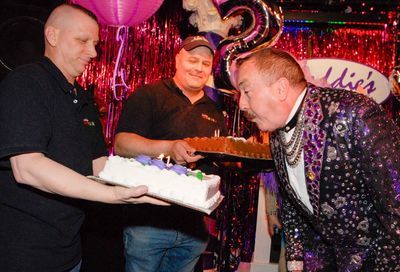First Lady of Leather
Interview with Mary Elizabeth Boyd
Photography by Todd Franson
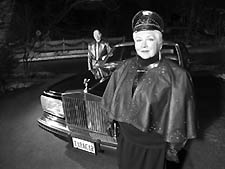 |
“Many times, I see people who I call ‘sniffers.’ They come to the hotel where MAL is held and look around thinking, ‘What the hell is this? Oh, my god! ” Mary Elizabeth Boyd leans forward in her chair and shakes her head. “Well, ” she continues. “We’ve all been to the point of ‘What is this?’ ”
Boyd sailed past that point years ago. Her life, one could almost say, has been partially spent engulfed in a leather dream, a dream that started when Boyd was a young girl growing up in Amelia Courthouse, Virginia, just outside Richmond.
Boyd, unique a child as she is an adult, was drawn to the look, to the scent, to the feel of leather.
“I guess it was because I lived where there were horses and leather, ” she says. But it wasn’t until she saw her first Tom of Finland WWII illustration that the budding young artist had an epiphany.
“It changed my life, ” she gasps, fanning herself with a small notepad. “When I saw those Tom of Finland drawings, I thought I was going to jump out of my skin. I wanted to draw those boots myself — I wanted to put the shine on ’em. ”
Currently a successful interior designer, Boyd, 62, identifies as straight (“But does it really make a difference? ” she smiles). A 17-year marriage, which produced a daughter, ended in the early ’70s. Several years later, Boyd moved on to a new adventure — a relationship with a gay leatherman, one that lasted eight years before his death in 1991 from AIDS.
After her companion’s death, Boyd ventured full steam ahead into the D.C. leather community, not exactly knowing if she’d be fully accepted into this gay Men’s Only Club.
She was more than accepted — she was heralded, eventually, as the community’s First Lady of Leather. Renowned, respected, and revered throughout the international leather community, Boyd is at virtually every function, dressed to the leather nines, just as she’ll be this weekend at the Centaur MC’s Mid-Atlantic Leather Weekend 2003, the largest such gathering of leather organizations on the East Coast.
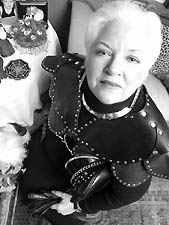 |
Boyd’s road to achieving uniqueness as a person has not been without effort.
“I feel like I was born with a machete in my hand, ” she says, her Southern accent warm yet resolute, “and I’ve been cutting my way through life’s jungle ever since. ”
She does not identify as a mistress or a dominatrix, but she’s coy when asked if she’d ever taken on those roles.
“What I do, I do in secret, ” she laughs. “You would have to participate to find out. ”
Metro Weekly: What first attracted you to leather and the gay leather community?
Mary Elizabeth Boyd: It’s difficult to say where anything starts and stops with anybody because one day you’re just involved in it and you’re thinking, “When did this start? ” But I would say that it probably all came together during the disco era. I was disco dancing and every time I’d have a work trip, I’d try to hit some little gay spot where I could disco dance. And there were always leathermen around — particularly at the tea dances. Well, my eyes were checking those guys out. And I found that whenever I would dance on the floor, I’d always end up in the middle of the leathermen. And I remember it with just wonderful memories — shirtless men and sweat flying and the odors of the leather.
I remember one particular person — a very handsome man — asked me to dance. And I’m just jiving out on the floor, and all of the sudden I realized he has this flogger attached to his belt. And as we were dancing — I remember it so graphically — those leather strips were flying between my legs and hitting the insides of my calves and I thought, “Oh, my God, this is fabulous! ”
So it was kind of a progression. Leather men from those days would ask me to do things for dinner, and go to various functions. Everybody was living pretty high then. But eventually, my interests zoned in on one leatherman. And I lived a rather silent life with him for eight years.
MW: So you were living as a couple?
Mary: Yes, but I did not go out with him to the Eagle. I did not go out with him to parties. He was a member of one of the clubs here in Washington and he went to events. He had club meetings, he had club guys over. I was kind of behind the scenes.
MW: Was it a platonic relationship?
Mary: No. But it was a relationship that existed on a day-to-day basis. As long as it was good for both of us, we would go the next day. Because we never knew where it would go. It was a very unusual relationship.
MW: Don’t you put yourself emotionally at risk — being a straight woman — when you have a full-throttle relationship with a gay man?
|
Mary: Of course. But you put yourself at risk with any type of relationship. And as long as there’s something in it for both of you and it’s good for both of you and it’s going day-to-day, you continue. It was like being on a Merry-Go-Round. I knew that gold ring was there. And I could either be safe and just keep going on that Merry-Go-Round, or I could reach up for that golden ring and I might miss that ring. But I would always be sorry if I didn’t try for it.
I adored him. There were some shaky times — he was very ill. And maybe the relationship wouldn’t have lasted if he hadn’t been ill. But you don’t leave when a person is ill. This was during those times when everybody you knew was dying. We dealt with a lot of death. Once you were diagnosed, everybody knew you would die. There was no chance for life. So things were a little different and people behaved a little differently.
MW: What happened after he passed away?
Mary: It was very difficult for me to go out into the leather community because I had felt that I had always been behind the scenes. And yet, I had a great desire to do so. It took a little while for me to get up the courage. The pieces of his leather I wanted to wear — and not all of his leather did I want to wear — I had earned. That was the old style of leather. You didn’t just buy your leather, you earned your leather. It was a very special thing to you. And you held it in very high regard. When I first started going out, I felt a little self-conscious, because I felt like he was “seeing ” me out and maybe I shouldn’t be there. But that only lasted a little while.
MW: You have gained a certain prominence in the leather community, to the point where you’re almost a national leather icon. How did that happen?
Mary: For the life of me, I don’t know — except when I got going, I really got going. I started going out of town [to leather functions], and all of the sudden I knew everybody there. Suddenly, I’m given this title The First Lady of Leather. And I’m thinking, “What kind of title is this? Does this mean that I’m the oldest one out here? ” [Laughs.]
Well, the connotation was one of respect. The connotation was that I was — as I hope I always am — a lady. Regardless of what I do, I’ve always tried to maintain that image of being a lady.
MW: Over the years, the doors have opened to allow more participation of women in the leather community. Talk to me about the leather community’s transformation, as you’ve seen it, with regard to the attitude toward women participants.
Mary: I don’t know that I’m the best person to talk about this because, obviously from my conversations, I’ve played with the boys and I think sometimes the boys forget I’m a woman. But I will say the European Leather scene has no room for women at all, and I think that attitude originally transported here to the United States. I think in the past few years, however, the leather community realized that perhaps they had been discriminated against and that maybe they were discriminating against other folks in the same manner. I think things began to open up.
But it’s been a very difficult transition. Since I’m on the board of Leathersir/Leatherboy, which is an off-shoot of Drummer, it has been difficult for us in the dungeon when we have our international event. Because we want to be inclusive of women. And yet, a lot of people don’t feel comfortable playing scenes next to each other in a mixed situation.
It’s hard for me to discuss, because as I said, I’m not a typical woman in leather. I have never had any roadblocks to doing what I wanted to do. I’ve always been included. I’ve played basically with the boys. I know the protocol, and I know the discipline and the responsibility of playing with them. And I think that’s maybe why I was included.
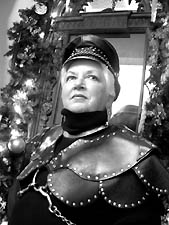 |
MW: Do you feel as though there has been progress in the way the general gay community responds to the leather community?
Mary: Yes — and no. Yes, in the fact that the leather community is large, and strong, and thriving in Washington, D.C. And when something is strong and thriving, it’s doing something right. They’re raising a heck of a lot of money for charities at every contest. There are other leather bars that have sprouted in Washington that are having leather activities — The Tool Shed and Titan. And I understand that there’s probably plans for more — meaning that there’s business for more.
But no, in the fact that the last March on Washington we had here in April, 2000, the leather community was plain told that we would be at the back of the parade, and “Please don’t wear your leather — wear normal stuff. ” Well, I don’t think that was very inclusive of who we were. But I think people are afraid of it. People are afraid of anything that pushes the envelope. And leather is pushing the envelope — it’s exploring new dimensions.
There are many levels of leather. There are levels from people who just enjoy putting on a vest every now and then, or a boot, and pretending and having a little fantasy, to people that are into heavy S&M. Leather is a journey — and you go along this journey exploring yourself. And as you go through your leather journey, some of the answers are there for you. It doesn’t mean that everybody gets to a level where they want to participate in the heaviest of S&M — but one man’s heavy S&M might be another’s light play.
MW: How do you feel when you dress up in leather?
Mary: I am very proud of my leather. I honor my leather. I take good care of my leather. In fact, I was told as a child the only thing I ever hung up was my cowgirl suit. Which was leather.
When I begin to put my leather on, I hear trumpets. And if I don’t hear trumpets, I’ve put on the wrong piece of leather, and I’ve got to go back and get another piece. Because when you feel like you look good in something, you hear those trumpets when you look in the mirror — you hear those trumpets.
Centaur MC’s Mid-Atlantic Leather Weekend 2003 runs from January 17-20. Several events — including Saturday’s Return the Beat Around at Apex, Sunday’s Mr. MAL Contest and Reaction Dance at Nation, and the free Leather Exhibit Hall at the Washington Plaza Hotel — are open to the public. A full weekend pass costs $125. For more details, see our Nightlife listings, visit www.leatherweekend.com, or call 1-800-494-8497.
Support Metro Weekly’s Journalism
These are challenging times for news organizations. And yet it’s crucial we stay active and provide vital resources and information to both our local readers and the world. So won’t you please take a moment and consider supporting Metro Weekly with a membership? For as little as $5 a month, you can help ensure Metro Weekly magazine and MetroWeekly.com remain free, viable resources as we provide the best, most diverse, culturally-resonant LGBTQ coverage in both the D.C. region and around the world. Memberships come with exclusive perks and discounts, your own personal digital delivery of each week’s magazine (and an archive), access to our Member's Lounge when it launches this fall, and exclusive members-only items like Metro Weekly Membership Mugs and Tote Bags! Check out all our membership levels here and please join us today!




















